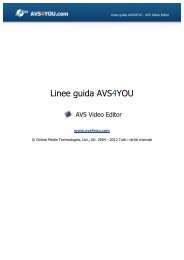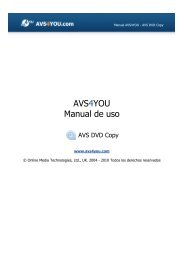AVS4YOU Programs Help - AVS Photo Editor - AVS4YOU >> Online ...
AVS4YOU Programs Help - AVS Photo Editor - AVS4YOU >> Online ...
AVS4YOU Programs Help - AVS Photo Editor - AVS4YOU >> Online ...
You also want an ePaper? Increase the reach of your titles
YUMPU automatically turns print PDFs into web optimized ePapers that Google loves.
<strong><strong>AVS</strong>4YOU</strong> <strong>Programs</strong> <strong>Help</strong> - <strong>AVS</strong> <strong>Photo</strong> <strong>Editor</strong> Page 24 of 42<br />
Rotating photos<br />
It's possible to rotate photos in the Preview Area counter clockwise and clockwise by 90 degrees. For<br />
this purpose use the Rotate CCW or Rotate CW option of the Edit section in the Main Menu, the<br />
corresponding option of the Express Menu, or the buttons situated on the toolbar and displayed on the<br />
right.<br />
Zooming in and out<br />
Note: the Rotate function will be disabled, if one of the Editing Tools is being used. In order to rotate your image,<br />
press the appropriate tool button at the Edit Tab to hide the settings area and deactivate the tool.<br />
To zoom the edited image in the Preview Area select the appropriate option of the View section in the Main Menu:<br />
Fit - use it to resize your image, so that it fits within the preview area.<br />
x1 - use it to view the edited photo in full size.<br />
x3 - use it to view the edited photo at 300% zoom.<br />
You can also use the slider situated on the toolbar and displayed on the right. The following options are<br />
available: one on screen, full size, 200%, 300%, 400%, 500%.<br />
It's also possible to zoom in and out the displayed image by scrolling the mouse wheel, if the mouse<br />
cursor is situated within the Preview Area while editing or within the Navigator window at the Edit<br />
Tab.<br />
While using the zoom function you can have a look at the Navigator window situated in the Edit<br />
Tab, where you can see the image area displayed at the moment within the Preview Area. So if<br />
you zoom in the image, the image area visible in the preview area will be displayed within the whiteoutlined<br />
rectangle in the navigator.<br />
While zooming in a photo some parts of the image won't be seen within the Preview Area, as this<br />
option zooms in to the center of the image. As soon as you zoom in the edited image, the mouse<br />
cursor will turn into a hand - . To move the image and see the area you need, click the mouse<br />
button (the hand becomes closed - ) and, without releasing it, drag the hand cursor in the desired<br />
direction.<br />
Supported Image File Formats<br />
Image file formats are standardized means of organizing and storing images. Image files are composed of either pixel or vector<br />
(geometric) data. So image formats are divided into three groups: raster formats, vector formats and metafile formats (include both<br />
vector and bitmap components).<br />
Raster formats store images as bitmap that is a data structure representing a generally rectangular grid of pixels, or points of color. A<br />
bitmap is technically characterized by the width and height of the image in pixels and by the number of bits per pixel. The greater the<br />
number of rows and columns is, the greater the image resolution is, and the larger the file is. Also, each pixel of an image increases in<br />
size when its color depth increases — an 8-bit pixel (1 byte) stores 256 colors, a 24-bit pixel (3 bytes) stores 16 million colors, the<br />
latter is known as truecolor. Image compression uses algorithms to decrease the size of a file.<br />
There are two types of image file compression algorithms: lossless and lossy. Lossless compression algorithms reduce file size without<br />
losing image quality, though they are not compressed into a file with the same small size as a lossy compression file. When image<br />
quality is valued above file size, lossless algorithms are typically chosen. Lossy compression algorithms take advantage of the inherent<br />
limitations of the human eye and discard invisible information.<br />
© <strong>Online</strong> Media Technologies Ltd., UK 2004 - 2010. All rights reserved. www.avs4you.com

















